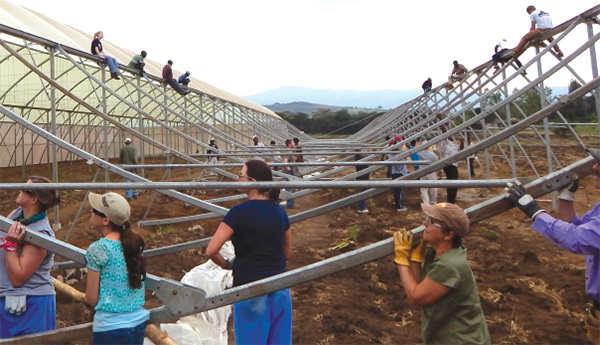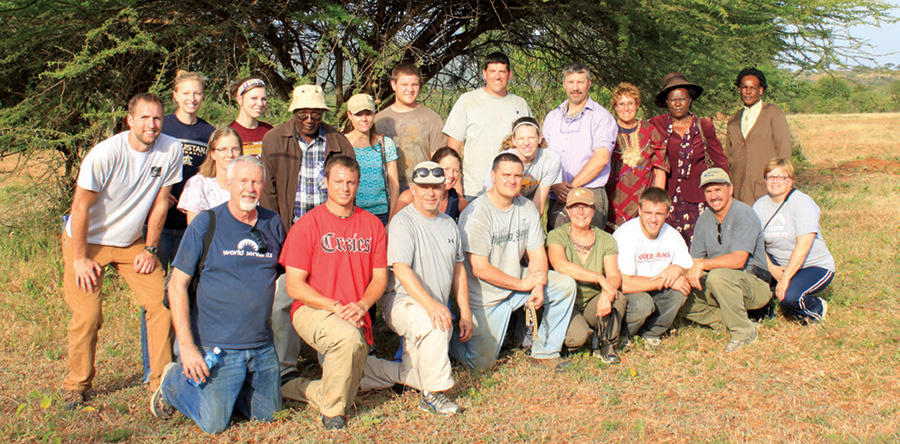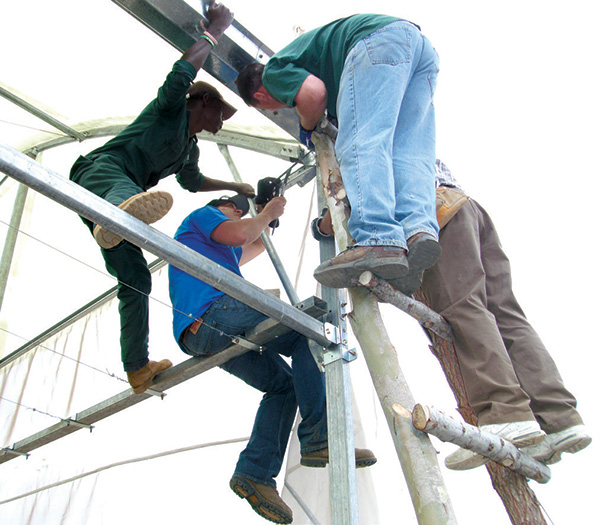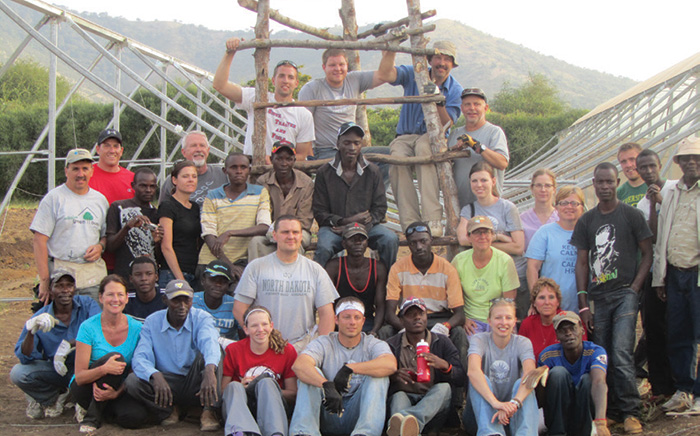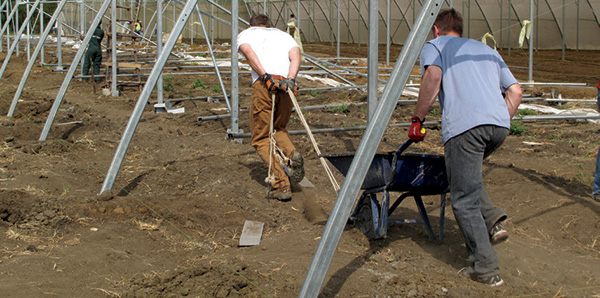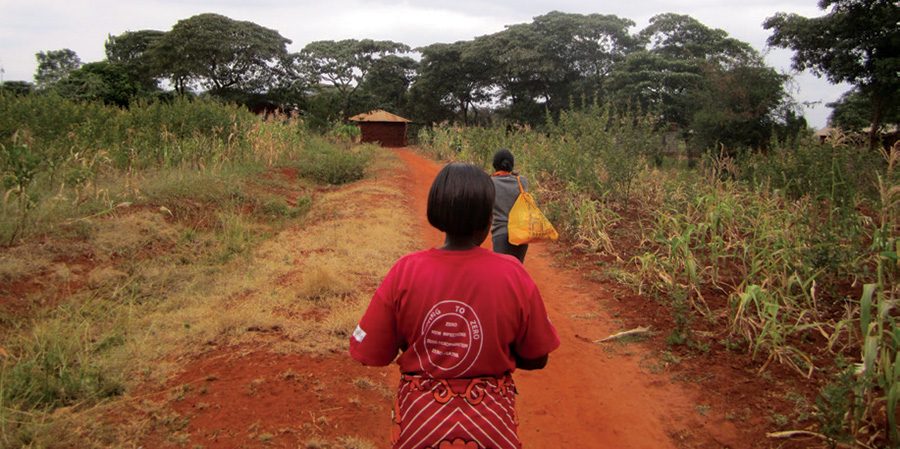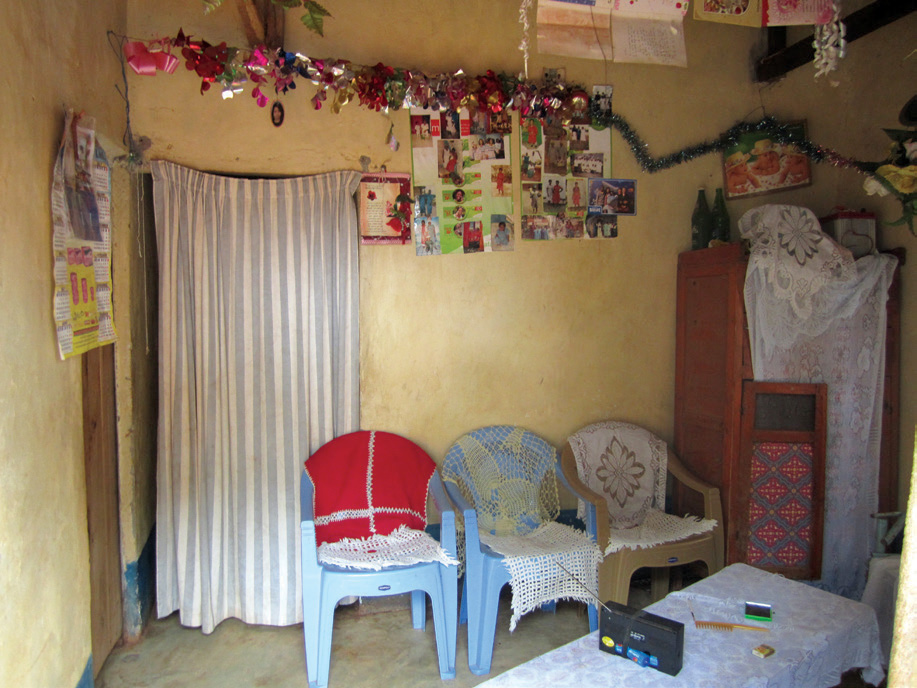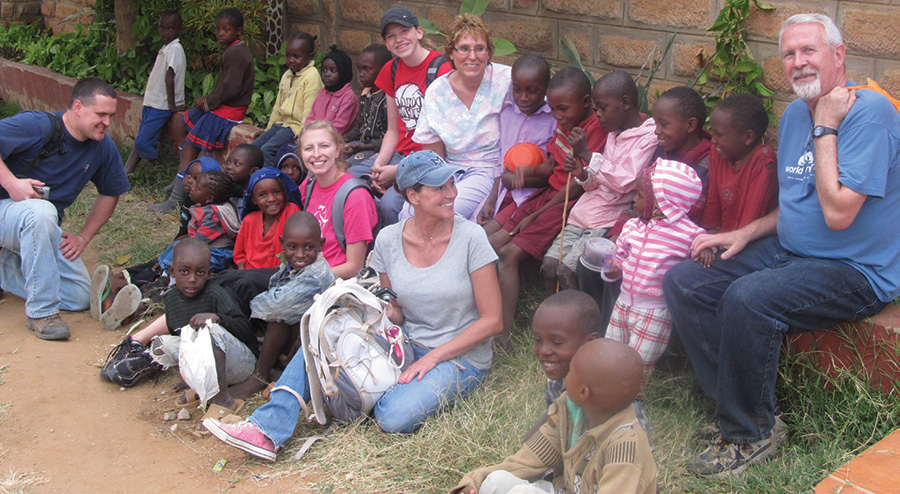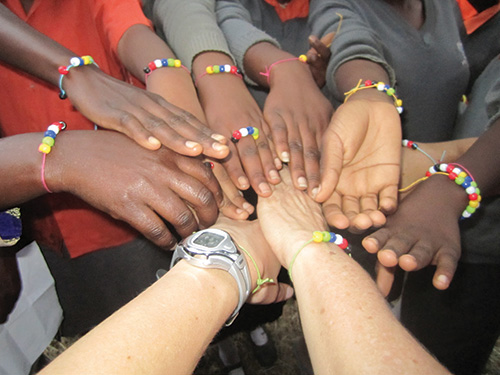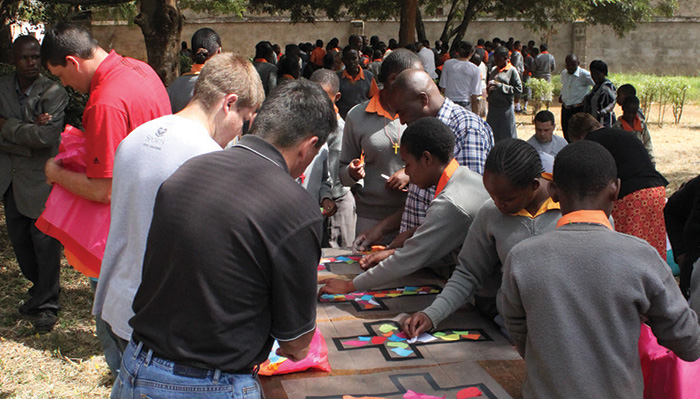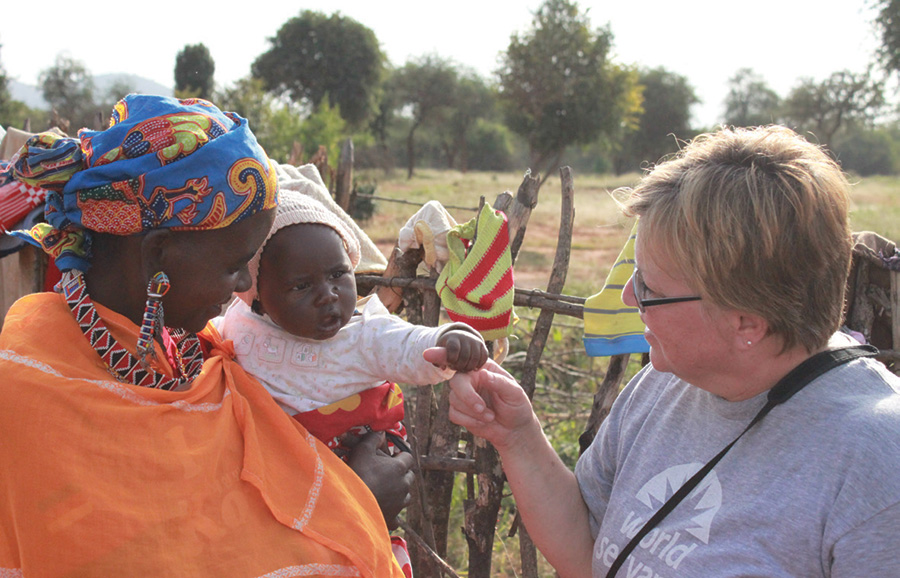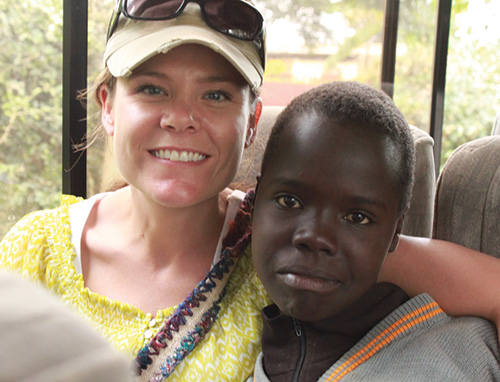After 28 hours of travel, five questionable airplane meals (no offense, Delta) and one large, smelly seatmate, I arrived at the Nairobi airport. Truthfully, the trip out wasn’t that bad. Our airplane mates were as excited for our trip as we were. With a few of us sporting our Mission Greenhouse t-shirts, people asked, “What exactly is your mission?”
We explained that we were building a greenhouse for the all-girls school, Traveller’s Oasis Centre (TOC), in Sultan Hamud, Kenya. The purpose of the greenhouse is to provide food for the school and to teach the girls the skills to be self-reliant.
They offered support and advice. Many having been on mission trips themselves. Some even quizzed us on our Swahili before arriving at the Nairobi airport.
Back row: (l-r) Josh Rensink, Kayla Schlechter, Miriam Sluis, Kristin Snelling, Ben, Tara Smith, Dan Machata, Neil Anderson, Emily Anderson, Ron Patton, Connie Hancock, Esther Muis Front Row: (l-r) Tim Gibson, Nick Eichacker, Larry Ward, Debbie Anderson, Linda Ward, Stevie Lewis, Steve Lewis, Barb Nyreen
“Jambo!” (Swahili for hello.)
That evening, we made it to the Methodist Guest House in Nairobi in one piece – a feat in itself. I can honestly say that I will never complain about Sioux Falls, S.D. traffic again.
We were greeted and treated with smiles during our entire trip. Though there are several Kenyan ways of life that I wouldn’t recommend living by, their hospitality is one that Americans could absolutely benefit from.
Their coffee is another. Some of it made it back to the U.S. in my suitcase. You’re welcome, Mom.
We’ve arrived
We spent our first day with our World Servants representatives, Tim and Diane. An organization that provides cross cultural short term mission trips, World Servants coordinated the logistics of the entire trip for POET.
Orientation included several cultural examples where we were taught how to adapt to the Kenyan culture, what would be offensive to Kenyans and mostly what not to do.
Our drive to Sultan Hamud was an interesting one. Now, in S.D. a three hour drive means covering a considerable distance at a reasonable pace. In Kenya, a three hour drive means dodging trucks, pedestrians (who, we were warned, do NOT have the right-of-way), a few cows, traveling at turtle’s pace while trying to spot wild giraffes out the window. Which we did. Want to see excitement? Check out a bus full of Midwesterners seeing their first wild giraffe.
The girls and players from a nearby futbol (soccer) tournament lined the road as we drove into the school in Sultan Hamud, a community of close to 2,000. Every bit of our practice to learn their language, Kikumba, was forgotten the minute we stepped off the bus, and we were lead to their chapel where several of the girls had prepared a program for us. They sang and presented skits for us on the dangers of AIDS and cigarettes. I was poked from the row behind me and this cute little girl with plaited hair shook my hand and grinned.
As the girls were dismissed, some stopped to give us hugs and handshakes. And we had our first encounter with Esther. This wonderful woman was small and soft spoken. The matron of the school, she welcomed us and thanked us for being there. I was a little bit caught off guard by her extreme gratitude. She told us of how the school started. Years ago, while she was eating her lunches, she saw young girls begging for food. She started giving away food from her lunches. Eventually, she started buying bread and milk for the girls. She went home one day and told her husband, Shadrack, that she had spent 20 schillings to buy food for these girls. He said, “20 schillings...? Here’s 100 schillings. We can do more.” And so the idea for TOC began.
Building Greenhouses
The word efficient doesn’t exist in Swahili. In our orientation, we were taught that Kenyans care more about relationships and being effective rather than being efficient. That’s an American word, we were told. They were right. Our first day on the greenhouse site was a slow one. Then to top it off, once we got things rolling, we stopped for tea time. I could see a little annoyance in the American crew. And I felt it a little myself. But, there was no skipping tea time in Africa.
Neil Anderson, Ron Patton and Beau Schmaltz, POET team members, work with Johnston, Kenyan contractor, on a greenhouse bracket.
We took a break and had tea, coffee, fresh papaya, mango and porridge. Yes, porridge. Mix it with sugar and it could rival some Starbucks drinks. By the end of the week, every one of us had tried porridge at least once and Esther had filled our plates two or three times. And breaking for tea time to visit with Esther, Ben and Simon was no longer an issue. I’ll admit, I wouldn’t be disappointed if POET started serving sweet bananas, fresh pineapple and porridge every day at 10:30 a.m.
Back on the work site, we were putting up the side supports to the greenhouse and beginning to mix cement by hand. Kenyan work techniques are very primitive – similar to the way the U.S. worked in the early 1900s. Cement was made by mixing crushed rock and water with a shovel and ladders consisted of tree branches nailed together. Our progress on the first day was minor, but slowly moving forward.
Esther brought her husband, Shadrack, to the worksite to meet the group. Shadrack is one of the most trained military officers in the Kenyan police. You’re probably picturing a formal military man. At first glance, he was. Then Shadrack’s sarcasm and wit won us over immediately. Upon meeting him, he gave me a hug, looked at me disapprovingly and said, “You eat more sausages.” And laughed and hugged me again. An American history buff, he spoke to us of how he admires America and he quoted President Lincoln.
The Kenyans and Americans worked together to build a greenhouse for TOC. Back row: Neil Anderson, Tim Gibson, Josh Rensink, Dan Machata, Ron Patton, Larry Ward, Stevie Lewis | Row 3: Steve Lewis, Tara Smith, Kristin Snelling, Miriam Sluis, Barb Nyreen | Row 2: Beau Schmaltz, Linda Ward | Front row: Debbie Anderson, Emily Anderson, Nick Eichacker, Kayla Schlechter
The progress from our second day on the work site was more significant. Knowing what needed to be done, we set to work immediately with direction from the Kenyan workers. Tea time came and unfortunately, our progress was not as far along as we would have liked it to be.
Josh Rensink and Stevie Lewis transport cement.
Esther had arranged home visits for us at some of the students’ homes for the day. Our group split into two – half set off towards the bus for home visits and the rest went back to work. At the greenhouse, we had seven brackets left to finish for the morning. No problem, right? Wrong. We finished three, finagling brackets to fit in holes that didn’t quite line up.
At lunch, the groups that had gone on home visits had a little trouble verbalizing what they saw. “So small…lovely woman…broke my heart…they are so happy,” were a few of the phrases I caught.
“You’ll see,” is what they told us.
Kenya dwellings
Swapping places, my group took off for the bus. Six girls jumped on our bus at the entrance of the school and directed our driver toward their homes. Fast friends was an understatement in this case. The Mission Greenhouse team and the TOC students immediately started asking each other questions. The Americans pulled out their cell phones and starting showing pictures of their kids, mothers, grandkids and homes. The students told us about their families, favorite school subjects and plans for the future.
Sarah and Josephine
We headed out of Sultan Hamud and dropped off the first few groups at homes along the way. Mothers, brothers and sisters were standing in the driveway to greet their guests. Josephine had jumped on the bus with us at a neighboring home and I was dropped off with her and her daughter, Sarah, at her home. As we walked up her red dirt driveway surrounded by sparsely planted corn, Josephine, wearing a shirt that asked to keep the promise to fight AIDS, asked us where we were from and what we were doing at the school.
When we reached her house, we ducked through the doorway and saw an 8x10 room filled with plastic lawn furniture. Josephine had covered the chairs in lace table cloths and sheets for us. Christmas bows and garland hung from the walls with pictures tacked to tag board. We were visiting one of the larger homes of the group. Sarah told us that she wanted to be a lawyer when she grew up. She had three older siblings – one now working in aviation, another in shipping logistics and the third attending university – and a younger brother. Her father died in 2002 – most likely AIDS-related we were told later by our World Servants reps. Sarah and her siblings had their school partially paid for by government funding. They were still looking for sponsors. Josephine told us how happy she was that we were here and thanked us over and over again for our help with the school.
At this point, it had started to cross my mind that we were getting more out of this than they were. The thought was echoed by the entire group that evening in reflection of the day.
Sarah and Josephine's home
We said goodbye to Josephine took some group photos and walked back to the bus. Sarah sat with me and asked question after question about my family and friends. She put her arm around my shoulders as we rode to the next home. Esther walked up to the bus at the next stop carrying a chicken and casually placed it under one of the seats. It was coming back to school with us. Picking up the other group of Americans from the worksite, we headed back to the school.
Mixing cultures
The girls were waiting for us in the yard when we got there. We stepped off the bus armed with soccer balls, jump ropes, sepas, Frisbees and other toys. The Americans and TOC students quickly mixed and challenged each other to jump-roping and sepa contests.
Emily Anderson, Connie Hancock, Tim Gibson, Beau Schmaltz, Kayla Schlechter and Debbie Anderson make friends with the Sultan Hamud children outside their hotel.
Both the Americans and the TOC students had to be pulled away from their games for the next activity. The Mission Greenhouse team had brought supplies to make Rainbow Faith Bead Bracelets with the girls. After going through the bracelet line, the girls came back again for a ring then for a necklace then for an earring then for another ring. They were thrilled that the extra string and beads would be staying with them for more beading projects.
Warriors
The greenhouse project came along more quickly with another full work-day (and tea, of course.) The side supports were finished and we had started to swing the top arches onto the greenhouse. It was our third workday and we left the worksite early to experience another African culture. Esther had arranged a visit to a Masai village. The Masai is who you might picture when you visualize authentic Africans. Still true warriors, they are the only group allowed in the wildlife parks to continue to hunt large game.
We were allowed into a Masai village outside of Sultan Hamud. Walking up we could see two mud huts that stood about 5 feet tall and a cattle pen made out of bunches of sticks. The women were dressed in expressive fabrics and covered in beads. There were no men to be seen. Inside their tiny 8x8 foot huts, they had beds, a kitchen and a sitting area. Not one of us could stand upright inside, including the Masai women. They are master bead crafters and sold us everything that they had available as we left.
Winding down
On our fourth and last day on the greenhouse site, we progressed quickly at first. However, we soon realized some of the pre-fab arches were drilled incorrectly. It felt like a one step forward, two steps back project. A m e r i c a n attention to detail and Kenyan attention to detail are two very different things we learned. We moved forward slowly and made some great friendships with the Kenyan workers. Though we didn’t finish the greenhouse during our time in Kenya, we were far from failing on the project. The Kenyans are more than capable of finishing and will have an easier time with the tools that were left behind.
Steve Lewis and Dan Machata help the girls make stained glass cross crafts.
Our last morning in Sultan Hamud was spent with the girls at the school. We learned names, made stained glass cross crafts and painted fingernails. We laughed and learned about each other’s cultures. The pictures show their beautiful brown eyes next to my blue eyes. The contrast is extreme, but it didn’t seem so as we sat next to each other.
Barb Nyreen meets a Masai woman and her son.
Esther had a surprise presentation for us as we left. Each one of us was presented with a hand-carved bowl as a gift of gratitude – gratitude that we felt towards them as heavily as they felt towards us. The girls lined the drive and sang to us as we walked out. They asked us not to forget about them.
Tara Smith and Faith learn about the other’s life and family.
I managed 10 days without American luxuries, a clean bathroom, internet and a cell phone. And in those 10 days, I fell in love with Africa by way of a woman named Esther and 120 young students at the Traveller’s Oasis Centre.
Asante Sana, Esther. Though we came here to help you, I believe you returned more to us than we gave. You provided us a life lesson in humility, gratitude and friendship. I left a bit of my heart with you and the girls in Africa.
Asante Sana. Thank you.
